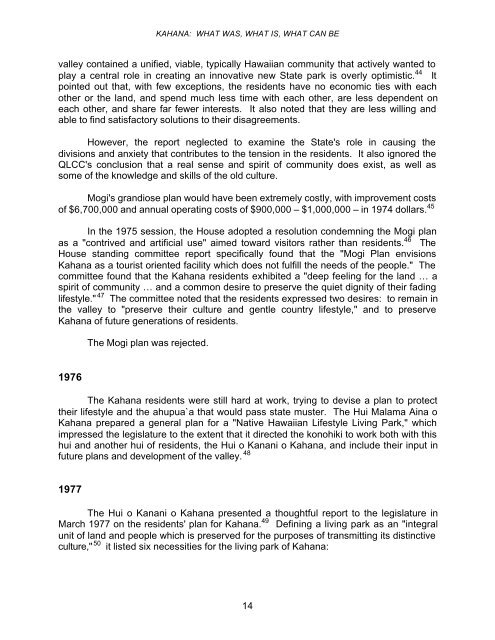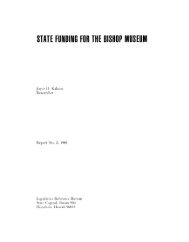Kahana: what was, what is, what can be. - Legislative Reference ...
Kahana: what was, what is, what can be. - Legislative Reference ...
Kahana: what was, what is, what can be. - Legislative Reference ...
You also want an ePaper? Increase the reach of your titles
YUMPU automatically turns print PDFs into web optimized ePapers that Google loves.
KAHANA: WHAT WAS, WHAT IS, WHAT CAN BE<br />
valley contained a unified, viable, typically Hawaiian community that actively wanted to<br />
play a central role in creating an innovative new State park <strong>is</strong> overly optim<strong>is</strong>tic. 44 It<br />
pointed out that, with few exceptions, the residents have no economic ties with each<br />
other or the land, and spend much less time with each other, are less dependent on<br />
each other, and share far fewer interests. It also noted that they are less willing and<br />
able to find sat<strong>is</strong>factory solutions to their d<strong>is</strong>agreements.<br />
However, the report neglected to examine the State's role in causing the<br />
div<strong>is</strong>ions and anxiety that contributes to the tension in the residents. It also ignored the<br />
QLCC's conclusion that a real sense and spirit of community does ex<strong>is</strong>t, as well as<br />
some of the knowledge and skills of the old culture.<br />
Mogi's grandiose plan would have <strong>be</strong>en extremely costly, with improvement costs<br />
of $6,700,000 and annual operating costs of $900,000 – $1,000,000 – in 1974 dollars. 45<br />
In the 1975 session, the House adopted a resolution condemning the Mogi plan<br />
as a "contrived and artificial use" aimed toward v<strong>is</strong>itors rather than residents. 46 The<br />
House standing committee report specifically found that the "Mogi Plan env<strong>is</strong>ions<br />
<strong>Kahana</strong> as a tour<strong>is</strong>t oriented facility which does not fulfill the needs of the people." The<br />
committee found that the <strong>Kahana</strong> residents exhibited a "deep feeling for the land … a<br />
spirit of community … and a common desire to preserve the quiet dignity of their fading<br />
lifestyle." 47 The committee noted that the residents expressed two desires: to remain in<br />
the valley to "preserve their culture and gentle country lifestyle," and to preserve<br />
<strong>Kahana</strong> of future generations of residents.<br />
1976<br />
The Mogi plan <strong>was</strong> rejected.<br />
The <strong>Kahana</strong> residents were still hard at work, trying to dev<strong>is</strong>e a plan to protect<br />
their lifestyle and the ahupua`a that would pass state muster. The Hui Malama Aina o<br />
<strong>Kahana</strong> prepared a general plan for a "Native Hawaiian Lifestyle Living Park," which<br />
impressed the leg<strong>is</strong>lature to the extent that it directed the konohiki to work both with th<strong>is</strong><br />
hui and another hui of residents, the Hui o Kanani o <strong>Kahana</strong>, and include their input in<br />
future plans and development of the valley. 48<br />
1977<br />
The Hui o Kanani o <strong>Kahana</strong> presented a thoughtful report to the leg<strong>is</strong>lature in<br />
March 1977 on the residents' plan for <strong>Kahana</strong>. 49 Defining a living park as an "integral<br />
unit of land and people which <strong>is</strong> preserved for the purposes of transmitting its d<strong>is</strong>tinctive<br />
culture," 50 it l<strong>is</strong>ted six necessities for the living park of <strong>Kahana</strong>:<br />
14
















